Laccolith
A laccolith is a sheet-like intrusion (or concordant pluton) that has been injected within or between layers of sedimentary rock (when the host rock is volcanic, the laccolith is referred to as a cryptodome[1]). The pressure of the magma is high enough that the overlying strata are forced upward and folded, giving the laccolith a dome or mushroom-like form (or possibly conical or wedge-shape) with a generally planar base. Over time, erosion can form small hills and even mountains around a central peak since the magma rock is likely more resistant to weathering than the host rock. The growth of laccoliths can take as little as a few months when associated with a single magma injection event,[2][3] or up to hundreds or thousands of years by multiple magmatic pulses stacking sills on top of each other and deforming the host rock incrementally.[4]
1. Laccolith
2. Small dike
3. Batholith
4. Dike
5. Sill
6. Volcanic neck, pipe
7. Lopolith
Note: As a general rule, in contrast to the smoldering volcanic vent in the figure, these names refer to the fully cooled and usually millions-of-years-old rock formations, which are the result of the underground magmatic activity shown.
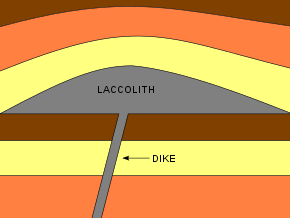
Etymology
The term was first applied as laccolite by Grove Karl Gilbert after his study of intrusions of diorite in the Henry Mountains of Utah in about 1875.[5] The word laccolith derived in 1875—1880, from Greek, lákko(s), meaning pond, plus -lith, meaning stone.[6]
Where laccoliths form
Laccoliths tend to form at relatively shallow depths and in some cases are formed by relatively viscous magmas, such as those that crystallize to diorite, granodiorite, and granite. In those cases cooling underground may take place slowly, giving time for larger crystals to form in the cooling magma. In other cases less viscous magma such as shonkinite may form phenocrysts of augite at depth, then inject through a vertical feeder dike that ends in a laccolith.[7] The surface rock above laccoliths often erodes away completely, leaving the core mound of igneous rock.
Examples
The filled and solidified magma chamber of Torres del Paine (Patagonia) is one of the best exposed laccoliths, built up incrementally by horizontal granitic and mafic magma intrusions over 162 ± 11 thousand years.[8] Horizontal sheeted intrusions were fed by vertical intrusions.[9]
The small Barber Hill syenite-stock laccolith in Charlotte, Vermont, has several volcanic trachyte dikes associated with it. Molybdenite is also visible in outcrops on this exposed laccolith. In Big Bend Ranch State Park, at the southwesternmost visible extent of the Ouachita orogeny, lies the Solitario.[10] It consists of the eroded remains of a laccolith, presumably named for the sense of solitude that observers within the structure might have, due to the partial illusion of endless expanse in all directions.[10]
One of the largest laccoliths in the United States is Pine Valley Mountain in the Pine Valley Mountain Wilderness area near St. George, Utah.
Problems reconstructing shapes of intrusions
The original shape of intrusions can be difficult to reconstruct. For instance, Devils Tower in Wyoming and Needle Rock in Colorado were both thought to be volcanic necks, but further study has suggested they are eroded laccoliths.[11][12] At Devils Tower, intrusion would have had to cool very slowly so as to form the slender pencil-shaped columns of phonolite porphyry seen today. However, erosion has stripped away the overlying and surrounding rock, so it is impossible to reconstruct the original shape of the igneous intrusion, which may or may not be the remnant of a laccolith. At other localities, such as in the Henry Mountains and other isolated mountain ranges of the Colorado Plateau, some intrusions demonstrably have the classic shapes of laccoliths.
On Earth's moon
There are many examples of possible laccoliths on the surface of the Moon.[13] These igneous features may be confused with impact craters.
Gallery
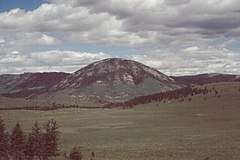 Laccolith exposed by erosion of overlying strata in Montana
Laccolith exposed by erosion of overlying strata in Montana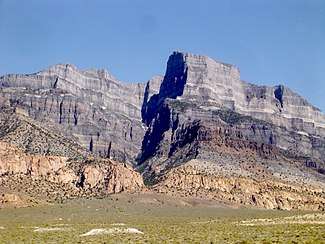 Pink monzonite laccolith intrudes within the grey Cambrian and Ordovician strata near Notch Peak, Utah
Pink monzonite laccolith intrudes within the grey Cambrian and Ordovician strata near Notch Peak, Utah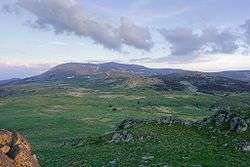
References
- Burchardt, Steffi; Mattsson, Tobias; Palma, J. Octavio; Galland, Olivier; Almqvist, Bjarne; Mair, Karen; Jerram, Dougal A.; Hammer, Øyvind; Sun, Yang (2019-08-14). "Progressive Growth of the Cerro Bayo Cryptodome, Chachahuén Volcano, Argentina—Implications for Viscous Magma Emplacement". Journal of Geophysical Research: Solid Earth. 124 (8): 7934–7961. Bibcode:2019JGRB..124.7934B. doi:10.1029/2019JB017543. ISSN 2169-9313.
- Castro, Jonathan M.; Cordonnier, Benoit; Schipper, C. Ian; Tuffen, Hugh; Baumann, Tobias S.; Feisel, Yves (December 2016). "Rapid laccolith intrusion driven by explosive volcanic eruption". Nature Communications. 7 (1): 13585. Bibcode:2016NatCo...713585C. doi:10.1038/ncomms13585. ISSN 2041-1723. PMC 5123016. PMID 27876800.
- Mattsson, Tobias; Burchardt, Steffi; Almqvist, Bjarne S. G.; Ronchin, Erika (2018-02-05). "Syn-Emplacement Fracturing in the Sandfell Laccolith, Eastern Iceland—Implications for Rhyolite Intrusion Growth and Volcanic Hazards". Frontiers in Earth Science. 6: 5. Bibcode:2018FrEaS...6....5M. doi:10.3389/feart.2018.00005. ISSN 2296-6463.
- Morgan, Sven; Stanik, Amy; Horsman, Eric; Tikoff, Basil; de Saint Blanquat, Michel; Habert, Guillaume (April 2008). "Emplacement of multiple magma sheets and wall rock deformation: Trachyte Mesa intrusion, Henry Mountains, Utah". Journal of Structural Geology. 30 (4): 491–512. Bibcode:2008JSG....30..491M. doi:10.1016/j.jsg.2008.01.005.
- Aber, James S. "Grove Karl Gilbert". academic.emporia.edu. Retrieved 29 December 2018.
- "laccolith". dictionary.com. Retrieved 29 December 2018.
- "Beall, Joseph J." "Pseudo-Rhythmic Layering in the Square Butte Alkali-Gabbro Laccolith." American Mineralogist. 57:7-8 (July–August 1972).
- Leuthold, Julien; Müntener, Othmar; Baumgartner, Lukas; Putlitz, Benita; Ovtcharova, Maria; Schaltegger, Urs (2012). "Time resolved construction of a bimodal laccolith (Torres del Paine, Patagonia)". Earth and Planetary Science Letters. 325–326: 85–92. Bibcode:2012E&PSL.325...85L. doi:10.1016/j.epsl.2012.01.032.
- Leuthold, Julien; Müntener, Othmar; Baumgartner, Lukas; Putlitz, Benita (2014). "Petrological constraints on the recycling of mafic crystal mushes and intrusion of braided sills in the Torres del Paine Mafic Complex (Patagonia)" (PDF). Journal of Petrology. 55 (5): 917–949. Bibcode:2014JPet...55..917L. doi:10.1093/petrology/egu011.
- Spearing, Darwin. Roadside Geology of Texas. 1991. Mountain Press Publishing Company. ISBN 978-0-87842-265-4.
- Vitaliano, Dorothy B. "Geomythology: geological origins of myths and legends" in Myth and Geology, ed. L. Piccardi and W. B. Masse, p. 1. Geological Society of London. ISBN 978-1-86239-216-8
- "Noe, D. C., and Alexander T. Klink. OF-15-06 Geologic Map of the Crawford Quadrangle, Delta and Montrose Counties, Colorado. 1:24,000". Colorado Geological Survey. Retrieved 26 July 2019.
- Wichman, R.W. and Schultz, P. H. (1996) Crater-Centered Laccoliths on the Moon: Modeling Intrusion Depth and Magmatic Pressure at the Crater Taruntius, Icarus, Volume 122, Issue 1, July 1996, pages 193-199. doi:10.1006/icar.1996.0118
- Georgiev, N.; Henry, B.; Jordanova, N.; Jordanova, D.; Naydenov, K. (2014). "Emplacement and fabric-forming conditions of plutons from structural and magnetic fabric analysis: A case study of the Plana pluton (Central Bulgaria)". Tectonophysics. 629: 138–154. Bibcode:2014Tectp.629..138G. doi:10.1016/j.tecto.2014.02.018.
- Blatt, Harvey and Robert J. Tracy, 1996, Petrology: Igneous, Sedimentary and Metamorphic, 2nd ed., pp. 13–15, Freeman, ISBN 0-7167-2438-3
- Jules D. Friedman and Curtis Huffman, Jr., coordinators, "Laccolith Complexes of Southeastern Utah: Time of Emplacement and Tectonic Setting -- Workshop Proceedings", United States Geological Survey Bulletin 2158, 1998.
- Hyndman, D. W. and D. Alt "Radial Dikes, Laccoliths, and Gelatin Models." ' 'Journal of Geology. 95:763-774.
External links

